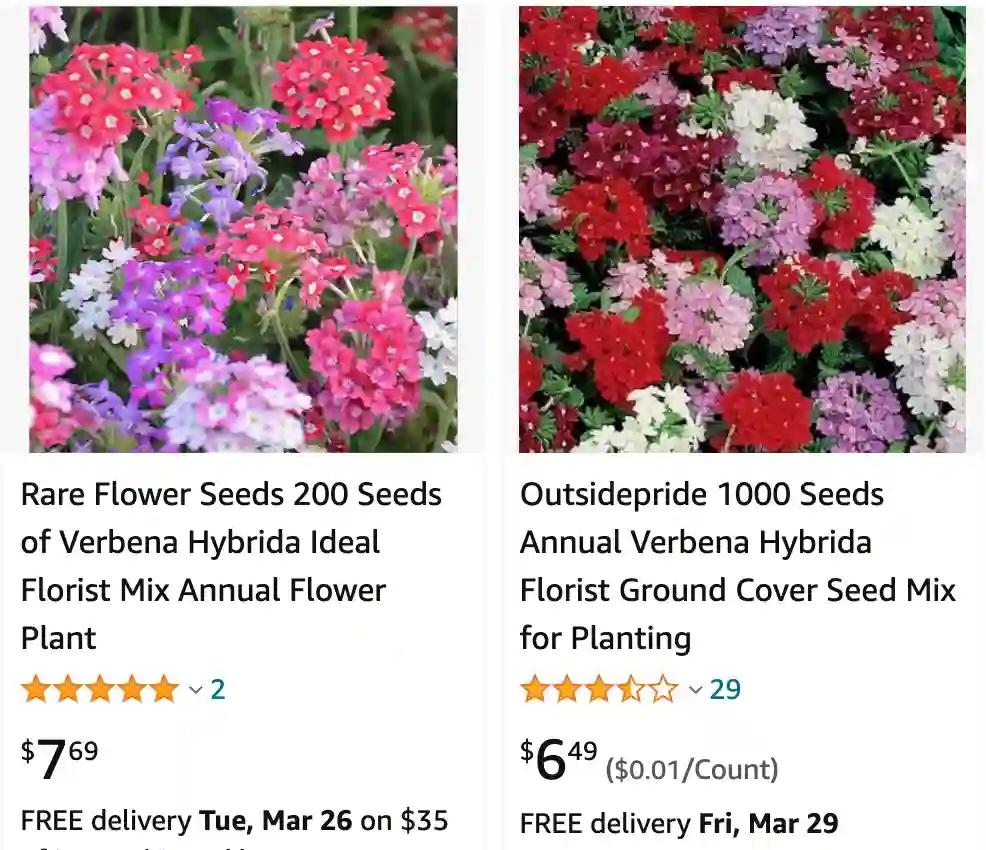Introduction
When it comes to transforming my garden into a vibrant haven, Verbena hybrida has been my go-to choice. The journey with this enchanting plant has been nothing short of a colorful adventure, from its cultivation to witnessing the blooming spectacle each season. In this post, I’ll share my personal experiences, gardening tips, and the sheer joy that Verbena hybrida has brought to my outdoor space.


Cultivation: Nurturing Radiance in St. Louis
According to my actual experience, cultivating Verbena hybrida in St. Louis demands attention to specific details. As a short-lived perennial, it becomes an annual in my region, thriving in average, well-drained soils with a penchant for full sun. What I discovered is that while it tolerates light shade, the best flowering occurs when basking in full sun. Heat and drought tolerance make it a resilient companion in my garden, but I’ve learned to avoid overhead watering as much as possible to ensure its well-being.
Each spring, the anticipation builds as I start the seed strains indoors, a good 8-10 weeks before the last frost date. While local nurseries offer convenient six-packs, there’s a unique satisfaction in nurturing these plants from their earliest stages. Young plants benefit from a strategic pinch to promote bushier growth, and deadheading spent flowers becomes a ritual to encourage a continuous bloom. The rhythm of this cultivation process has become a personal gardening symphony, a connection to nature’s cycles.
The Allure of Verbena Hybrida: A Feast for the Senses
Vibrant, vigorous, and versatile, Verbena hybrida has become a staple in my garden, turning it into a visual feast. In full bloom from late spring to fall, the small, five-petaled flowers gather in rounded clusters, creating a spectacle that attracts hummingbirds, butterflies, and a variety of pollinators. What I love is the diversity of flower colors – blue, violet, purple, rose, dark red, yellow, white, and even captivating bicolor varieties.
In my experience, the Superbena® series has proven to be a gem, with robustness, mildew resistance, and resilient qualities that outshine older varieties. The Tapien® series, trailing gracefully, and the Lanai® series, flaunting bold patterns, have also found their place in my garden, adding layers of beauty and charm.
Planting and Care: A Symphony of Colors Unfolding
Planting Verbena hybrida has become an annual celebration in my gardening calendar. Timing is crucial, with a preference for midspring or early summer, post the threat of frost. My journey with growing from seed has been a delightful learning curve, especially understanding that non-seeding hybrids require a different approach. Starting them indoors, I’ve marveled at the transformation from seeds to vibrant blooms.
Watering, fertilizing, pruning, and deadheading – these have become the notes in the melody of caring for my Verbena hybrida. While drought-tolerant, regular watering ensures optimal health, and pairing it with compatible plants enhances the overall garden aesthetics. The satisfaction of nurturing these plants is amplified when they reciprocate with a burst of colors, and the occasional trim becomes a meditative act, fostering fuller plants and prolific flowering.
Troubleshooting Verbena: A Fuss-Free Companion
In my gardening journey, Verbena hybrida has proven to be a fuss-free companion. The occasional challenges, such as leggy plants or sparse flowering, often trace back to insufficient sunlight or poorly drained soil. The troubleshooting process has become a personalized dance of observation and care. Moving them to sunnier spots, avoiding overhead watering, and ensuring proper drainage have been my keys to overcoming these challenges.
Powdery mildew, a common woe, finds its solution in adequate spacing and mindful watering practices. Yellowing leaves and root rot become signals for improved drainage, either through transplantation or additional drainage holes for container-grown plants. Dealing with spider mites, a rare concern, involves gentle interventions like spraying foliage with water or using insecticidal soap, always mindful of the delicate balance in the garden ecosystem.
Growing, Maintaining, and Using Verbena: A Complete Guide from My Garden
Growing Verbena hybrida from seeds or cuttings has become a cherished part of my gardening routine. The meticulous process, from refrigerating seeds to the joy of seeing sprouts, reflects the commitment to nurturing life. Propagation through cuttings adds another layer of connection, each new plant carrying the legacy of its parent.
Maintenance, to me, is an act of harmonizing with nature. While established plants showcase resilience, consistent irrigation and well-drained soil elevate their well-being. Fertilizing becomes an art, with garden beds thriving on slow-release fertilizer, and container plants enjoying routine nourishment. Pruning and deadheading, not just tasks but expressions of care, enhance the longevity and vibrancy of my Verbena hybrida.
Beyond its ornamental allure, Verbena hybrida has a rich history of herbal usage. While not personally delving into its medicinal aspects, knowing its place in herbalism adds another layer of appreciation for this versatile plant. The FAQs, addressing aspects like dormancy, invasiveness, and toxicity, provide a comprehensive understanding of Verbena hybrida’s characteristics.
Conclusion: Verbena Hybrida – A Symphony of Nature in My Garden
In conclusion, my journey with Verbena hybrida transcends the realm of gardening. It’s a symphony of colors, a dance with nature, and a personal connection with the cycles of growth and bloom. From the careful cultivation to troubleshooting challenges and reveling in its ornamental glory, Verbena hybrida has become an integral part of my garden narrative. As I look forward to each new season, I anticipate not just the blooms but the continuation of a beautiful journey with this radiant and resilient plant.



